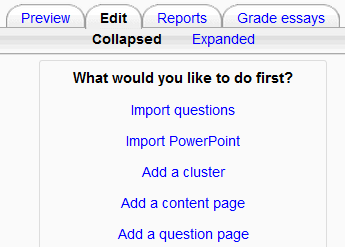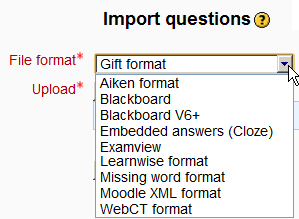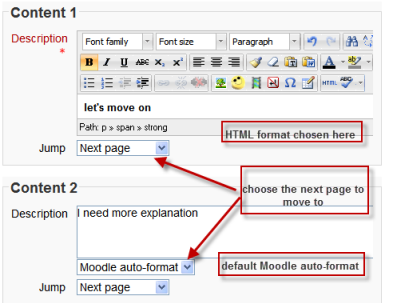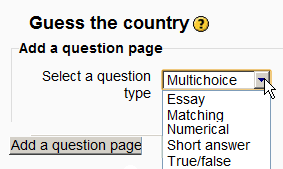Building Lesson: Difference between revisions
Mary Cooch (talk | contribs) (rephrasing and tidying up) |
Mary Cooch (talk | contribs) (more tidying up - more to come) |
||
| Line 67: | Line 67: | ||
====Numerical==== | ====Numerical==== | ||
*This requires a number as an answer. A number within a range may also be accepted as correct. | *This requires a number as an answer. A number within a range may also be accepted as correct. | ||
===Short answer=== | ====Short answer==== | ||
*A student must provide a single word or short phrase answer. The teacher must anticipate the possible answers and enter them in the Jump dropdown boxes, using ** wild cards if appropriate. | *A student must provide a single word or short phrase answer. The teacher must anticipate the possible answers and enter them in the Jump dropdown boxes, using ** wild cards if appropriate. | ||
====True/false==== | ====True/false==== | ||
| Line 73: | Line 73: | ||
+++++++++++++++work in progress below this line+++++++++++ | |||
===Ordered branches=== | ===Ordered branches=== | ||
A table of contents is an example of | A table of contents is an example of use of ordered branches. Typically a lesson may start with a Content page with the title "Table of Contents". The student selects a Description button and jumps to a page in the edit order that starts a series of pages about that subject. At the end of an ordered branch, the student is given several options by a question or a content page, such as: "Go to the next page", "Start of the series again", "End the lesson", or "Return to the Table of Contents. [[Image:Lesson visual order graphic1.png|thumb|100px|center|TOC that leads to 3 ordered branches]] | ||
===Classic branches=== | ===Classic branches=== | ||
| Line 96: | Line 92: | ||
*[[Lesson_Pages#Branch_.28Branch_Table.29-_Choice_Pages|Choice pages gives]] detailed help about editing a branch . [[Adding_a_content_page|Adding a content page (branch table)]] reviews process. | *[[Lesson_Pages#Branch_.28Branch_Table.29-_Choice_Pages|Choice pages gives]] detailed help about editing a branch . [[Adding_a_content_page|Adding a content page (branch table)]] reviews process. | ||
Revision as of 15:33, 13 February 2012
This page really needs improving. Please see the page comments for suggestions of what to include, then remove this template when you're done.
This page is about how to strucure a Moodle lesson once you have created it with the Lesson settings.
Planning your lesson
- A lesson is made up of pages which may have content for the student to read or questions for them to answer. The questions can be created by the teacher or imported. The teacher decides the order in which these pages appear.
- You need to have a clear idea beforehand of what you want to do with this lesson. Is it to be a graded, linear learning experience? Or an ungraded, non-linear practice session? Will students be able to go back and revisit areas or is it just a once-only opportunity?
- Even those who are very comfortable working directly online might find it useful to note down on paper the direction they want their lesson pages to go in, rather than having to remember and visualise the navigation in their head.
- For hints and ideas about using the Lesson module, look at Using Lesson and [Lesson FAQ]]
Adding content and questions to your lesson
- When you have set up your lesson with the Lesson settings,click "Save and display" and you will be taken to the screen in the screenshot below.
- If you click "Save and return to course" instead, then click the "update" icon next to the lesson on the page and click "edit" in the Settings block>Lesson Administration
Import questions
- If you have some questions in the following formats, you can import them to use in your lesson by clicking the Import questions link.
Import a powerpoint
- Although this setting is available, it really does not work and is not advised. See Import PowerPoint for alternatives.
Add a cluster
(work in progress)
Add a content page
- This is a page where a teacher can provide information to move the lesson forward but without requiring the student to answer specific questions.
- The student sees the page's title, some information and then one or more buttons at the bottom to select.
- When the student clicks on a button, they go to the next page but their choice is not scored.
Title
- The title of a content page appears to the student at the top of the page.
- A teacher will also see the title in the collapsed edit mode when they are working on the Lesson, and they will also be able to choose the title (and hence this page) from the drop down "jump" lists.
- The title in a content page is also used with the "display left menu" setting.
Page contents
This is where the tacher can add information for the student,making use of the Text editor and its multimedia features.
Content
- Here the teacher writes the words they want the student to click on to get to the next part of the lesson.
- These words will appear to the student as a button.
- The teacher can check the box to have the buttons appear horizontally, or uncheck it for them to appear centred vertically.
Format
There are 4 format types to choose from when editing text in the content description box. If you wish to have the usual rich text editing icons,choose HTML format. (Note - once you have selected an option, you cannot then go back and change your mind!)However, if you DO choose HTML format, be warned that the student will not see the changes (such as bold or different colours) in the button.
Number of options available
- How many of these you have depends on your choice in the Maximum Number of Answers setting in Lesson settings
The Jump
- Each Description in a Content page has a Jumps menu. "Jumps" take a student from one page to another.
- The teacher chooses from the dropdown the correct page to send the student to if they click on the button that will be made from this particular description. Any pages created by the teacher will have their titles appear in this dropdown, allowing them to be selected.
- When a student clicks on a description button, they are sent to the page defined in the Jump associated with the button.
Add a question page
- From this link you can choose from a variety of question types which will then be added as pages to your lesson:
- (Note: These question types are not the same as for the Quiz and are in no way connected with quiz questions.)
Multichoice
- The student is given a question and a list of answers. The answer list will be shuffled every time the question is view by a student. By default they choose one answer but you can check the box "multiple answer" to allow them to choose more than one answer.
Essay
- Students can write a longer answer as part of the lesson and this can be graded manually by the teacher. If the main purpose of your lesson is for students to write an essay, consider the Assignment module instead.
Matching
- This allows you to set up lists which must be matched against other lists, for instance, words, pictures, numebers etc. The student must match all correctly to receive the score.
Numerical
- This requires a number as an answer. A number within a range may also be accepted as correct.
Short answer
- A student must provide a single word or short phrase answer. The teacher must anticipate the possible answers and enter them in the Jump dropdown boxes, using ** wild cards if appropriate.
True/false
- The student is given a sentence and must decide if it is true or false.
+++++++++++++++work in progress below this line+++++++++++
Ordered branches
A table of contents is an example of use of ordered branches. Typically a lesson may start with a Content page with the title "Table of Contents". The student selects a Description button and jumps to a page in the edit order that starts a series of pages about that subject. At the end of an ordered branch, the student is given several options by a question or a content page, such as: "Go to the next page", "Start of the series again", "End the lesson", or "Return to the Table of Contents.
Classic branches
The classic branch is an advanced navigational feature. It introduces random movement within a series of pages that the teacher determines. A classic branch needs a Branch Table at the start of the series and a special navigation page called "End of Branch" at the end of the series.
The default jump in an "End of Branch" page is the preceding content page as an absolute jump. After a classic branch has been created, the teacher will see 3 new relative jump options: "Unseen question within a branch", "Random question within a branch" and "Random branch page". The classic branch with its "end of branch" navigation page is similar to a cluster.
- Tip: As with any advanced navigational feature, it is best to add it after the basic question and content pages have been created. Checking the Lesson's behavior in a student role is another best practice with highly adaptive lesson formats.
Tips when using branches
- The number of links shown when setting up or editing a content or a question page is set by the Lesson settings. This parameter can be changed on the fly by clicking on the Settings block >Lesson administration >edit settings link.
- When a lesson includes one or more ordered or classic branches, teachers need to decide if their students must visit every branch. By adding a question or two in each branch, the teacher can set the "Edit settings" Minimum number of Questions]]" parameter to some reasonable number of questions that must be answered. Without this parameter a student might visit a single branch in the lesson, answer all its questions correctly and leave the lesson with the maximum grade based upon their attempts, not the total number of available questions.
- Remember that using branches may encourage a student to revisit a question page more than once. This can impact scoring. Since scores can not be displayed for a teacher, it is a good practice for a new Moodling Teacher to log in as a student to check how the score is kept in their Lesson.
- Choice pages gives detailed help about editing a branch . Adding a content page (branch table) reviews process.




